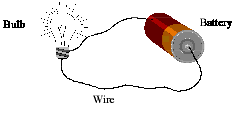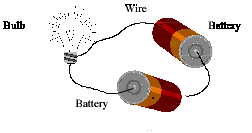TRB 5:4 - Activity 4: Wiring a Circuit
Summary
Students will create a circuit and then predict the effect adding or of changing one or more of the components.
Materials
- assortment of batteries,wires,and bulbs or motors.
Software:
- Kidpix, especially Science stamps
- Science Court by Tom Snyder, Electric Current, Grades 4-6 Package includes
CD-ROM, teacher's guide, student reproducibles, and poster.
Tom Snyder Productions
80 Coolidge Hill Road
Watertown, A 02472
(800) 342-0236 Fax (800) 304-1254
http://www.tomsnyder.com
Background for Teachers
A series circuit is a circuit that consists of more than one power source or more than one load. These pieces of the circuit are wired in series, one part following another.
Intended Learning Outcomes
1-Use science process and thinking skills.
Instructional Procedures
Attachments
-
circuit.pdf
Circuit Predictions Data Sheet -
image27.gif
-
image28.gif
Invitation to Learn
Review previous lessons.
Instructional Procedures:
- Instruct each group to assemble a basic circuit consisting of one battery,
two wires, and a bulb.

- Before continuing, each student should make a written prediction of what will happen when another battery is included in the circuit.
- After recording predictions, each group will put an extra battery in the
circuit, series style, and then record the result.

- Continue making predictions and adding batteries. Use caution since too many batteries will burn out the bulbs.
- Begin again with only one battery. Make predictions about what will happen with more than one bulb or motor.
- Conclude by making generalizations about the effect of greater loads and the effect of greater power supply.
- Complete the "Circuit Predictions" data sheet.
Extensions
- Try using fans or motors for the load. Try using a solar panel for the power source.
- Use Kidpix or PowerPoint to make a slideshow of what happens when extra batteries, or bulbs, are added to a circuit.
- Students create a “city” using milk cartons. Add a power source,
loads, and electrical pathways. Nine-volt batteries and small lights with
alligator clips work well, but many things would also work. Students should
be encouraged to decorate the city as creatively as possible.
Assessment Plan
Students create a chart to record predictions and observations. Write a step-by-step description of the path the electricity follows through the circuit.
Bibliography
This lesson is part of the Fifth Grade Science Teacher Resource Book (TRB3) http://www.usoe.org/curr/science/core/5th/TRB5/. The TRB3 is designed to be your textbook in teaching science curriculum to your students. This book covers all the objectives of each standard and benchmark. If taught efficiently, a student should do well on the End-of-Level (CRT) tests. The TRB3 is designed for teachers who know very little about science, as well as for teachers who have a broad understanding of science.
Updated: 10/10/2022


 UTAH EDUCATION NETWORK
UTAH EDUCATION NETWORK

 Justin
Justin Braxton
Braxton Dani
Dani Kayla
Kayla Katie
Katie Matthew
Matthew Rob
Rob Val
Val
